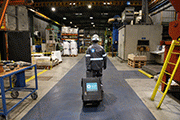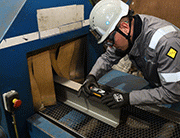E-Archive
From the World of Blasting
in Vol. 26 - September Issue - Year 2025
What Top-Performing Metal Finishing Programs Do That You Don’t

W Care expert operating the monitoring board

W Care expert arriving at a customer facility for machine service

W Care expert using the WA Clean tool to measure surface cleanliness
In my travels through shops across the country, I’ve seen every type of abrasive blasting operation imaginable—some tuned to perfection, others plagued by reactive maintenance and inconsistent results. While most facilities understand that blasting is critical to downstream quality, too many still treat it as just another step in the process. And when quality issues appear in coating or corrosion resistance, they’re left scrambling to diagnose problems retroactively.
Top-performing finishers don’t work that way
They prevent issues before they happen by monitoring every relevant data point—upstream, in-process, and downstream. Then they act on those signals quickly.
They’re Obsessed with Data
Elite finishing programs are data-driven to the core. They constantly monitor critical blast machine metrics like:
• Blast wheel amps and speed to maintain consistent energy transfer
• Abrasive flow rates and operating mix to ensure even coverage
• Separator curtain condition to avoid reusing fines and dust
• Wear part condition to prevent cascading failures
• They don’t just wait for failure—they predict it, prevent it, and document it.
They Look Beyond the Machine
The best shops know that blasting performance is affected by more than just the machine itself. They monitor:
• Pre-blast part condition – Is the incoming steel corroded, oily, or scale-heavy?
• Load volume – Are they overloading the machine and diluting blast intensity?
• Time before coating or packaging – Are parts sitting exposed too long, risking flash rust or contamination?
These factors often determine whether a part passes QC—not the blast machine alone.
They Invest in Process Control
These shops run like clockwork because they’ve built systems that self-correct:
• Automated alerts if amp draw drops unexpectedly
• Checklists for wear part inspections
• Routine sieve analyses and discard evaluations
• Consistent feedback between production, maintenance, and QA
They don’t just have operators—they have process owners.
They Think Proactively, Not Reactively
At underperforming shops, the common refrain is:
"We didn’t notice until parts started failing QC."
Top performers? They notice when amps drop by 3%. When reclaim volume dips slightly. When one abrasive screen is slower to fill.
They act on signals early—because in metal finishing, small problems become big fast.
The Bottom Line
The blast machine is often the heartbeat of a metal finishing line. If it’s neglected or poorly understood, it will quietly degrade every downstream process. But when it’s managed proactively, with full-spectrum monitoring and predictive action, it becomes a quality engine.
So if you find yourself constantly diagnosing issues after they’ve occurred, ask yourself:
What are the top finishers doing that I’m not?
The answer, most likely, is simple:
They’re watching everything—and acting before it’s too late.
Contact: chris.prouty@winoa.com
Written by Chris Prouty, Contributing Editor for MFN and Technical Advisor at Winoa



























